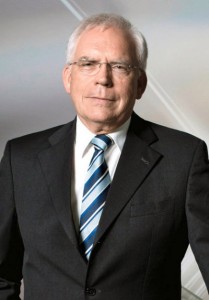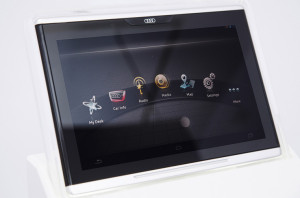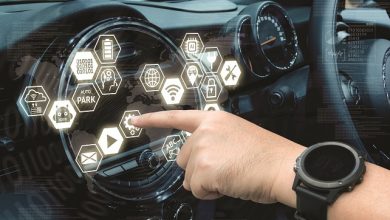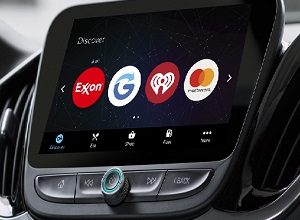Audi demystifies the potential of 'Swarm Intelligence' in the automotive niche
Published: October 02, 2014 | Hanover
At the CarIT Congress in Hanover, top-notch speakers and participants lecture and discussed one of the industry’s most important subject areas “Connected Cars”. Audi’s senior board level executive Dr. (Prof) Ulrich Hackenberg explains the future of cars during his keynote, namely, Car-to-World – the Audi Networking Strategy. He also explains as how Audi is aligning all its activities according to its motto ‘Vorsprung durch Technik’ ( advancement through technology).
Here is a short excerpt and the gist of his keynote speech.
Securing the largest ‘mobile’ device- The CAR

In upcoming years, the key priority of the automotive industry will be to shape the future of mobility and we are developing products, that are efficient and sustainable, connected and intuitive. We are creating a new dimension of connected reality with high-performance assistance systems, connected infotainment and car-to-car communication.
The mega-trends of the present are urbanisation, digitalisation and connectivity. By 2030, there will be 40% more smart phones on the market than today. Even today, 90% of smart phone users never have their phones more than one meter apart from them. And today, customers are already adopting the innovative pace of the consumer electronics industry as a standard for the pace of the automotive industry.
This makes the automobile the largest ‘mobile device’.
We see another enormous task and responsibility here: Big data – which for us means value-oriented customer management.
On the one hand, our customers expect convenient applications that give them continued access to information, fast processing and customised products and services. They rightly expect secure and confidential handling of their personal data. We have a clear and unwavering commitment to data protection, and we have established the highest levels of security standards in handling customer and vehicle data. We will not permit any unauthorised access to the operating system of our vehicles. When new services are conceptualised, our data security experts are involved in the process, and they support the entire development phase with security analyses.
Connectivity-The next big thing in the automotive industry
In 2010, we offered the first online services – which included weather, news and traffic information – in the Audi A8. Today, we have a comprehensive range of services for social media platforms, and we are extending them to the compact segment, too. Back in 1993, we only had a single bus system and five electronic control units in the Audi A8, but in 2010, the numbers were seven buses and more than 100 control units. Now we are seamlessly connecting the car with the Internet, the owner, infrastructure and other cars and allowing smartphone integration.
We see three stages of connectivity:-
Connected Infotainment : We are actually introducing a paradigm shift within the automotive industry. For years now we have been working together with leading companies in the semiconductor industry along the entire process chain. Our Modular Infotainment Platform (MIB) enables innovation cycles which are in line with those of the consumer electronics industry. Besides integrating RAM and flash memory, the plug-in module also integrates the latest Tegra processor from NVIDIA, which processes all of the online, media voice control, navigation and telephone functions. These h ardware components can be updated over the course of a car’s product lifecycle.
ardware components can be updated over the course of a car’s product lifecycle.
From 2012 to 2016, we increased our computing performance five-fold. At CES 2014 in Las Vegas, we presented the second generation of the MIB. There, we showcased a milestone in smart phone integration: the Audi phone box with wireless charging. This innovation has made wireless charging of mobile devices in the car a reality. We are also the first to develop a fully automotive-compatible tablet. The Audi tablet with its brilliant 10.2-inch HD screen can withstand extreme temperature fluctuations and mechanical shock. It is connected to the vehicle via Wi-Fi interface, and together with Audi connect, it offers Internet access using high-speed LTE.
In mid-September, our Audi TT was chosen the “best connected automobile in Germany”.
Car2X: We are connecting car drivers with the transportation system and making traffic light phases transparent. Over three-fourths of all German car drivers already deem this important today. The system displays the speed at which a driver needs to drive to pass through the next traffic light on a green wave without having to stop. We have already conducted live demonstrations in Las Vegas, Verona and Berlin. We developed this service based on generally accepted technical standards to guarantee a stable connection with traffic control servers. Traffic light info has the potential to reduce CO2 emissions by as much as 15 per cent.
Other future development opportunities are services that provide transfer points to local public transportation or pre-compute available parking spaces along a road. This would make life much easier. In some cities today, roving vehicles looking for parking spaces already represent one-third of vehicle traffic.
Car2Car OR Swarm Intelligence:90% of German car drivers already consider this functionality to be very important. Intelligent cars could help to save time and minimise risks.
Today’s assistance systems have the potential to navigate, guide and stabilise the car and the driver. This is particularly relevant in urban traffic situations with multi-tasking. Also, this is where our responsibility and job lies: Driving assistance systems and technologies such as piloted driving and parking can reduce stress, take on guidance and warning roles, make corrective actions in driving operation and assume driving tasks in special or emergency situations.
Just a few weeks ago, in California, we were the first company to be granted approval to test piloted driving on public roads. Now we can begin to test our technology platforms on the highways of the Golden State. That is significant progress for vehicle testing under real conditions, and it is close to the Audi Electronics Research Lab (ERL) in Belmont, CA.
Swarm intelligence will help piloted driving achieve a breakthrough. In addition to the sensor data that is generated in the car, information also comes from the infrastructure and other traffic participants.
Conclusion
The car is increasingly becoming a ‘mobile device’ on four wheels. Connectivity is the key to the car of the future, which makes it an integral part of our premium mobility product line-up. We have taken piloted driving and parking to production maturity, and we will be the first to introduce it to the market. Once again, we are demonstrating our power in technical innovation and ‘Vorsprung durch Technik’ as the DNA of our brand.
And there is much more to come along the pipeline. You can expect a lot from us – both today and in the future.
Stay tuned with Telematics Wire for the latest updates from the automotive and consumer electronics industry. :)))
[whohit]Audi demystifies the potential of ‘Swarm Intelligence’ in the automotive niche [/whohit]


